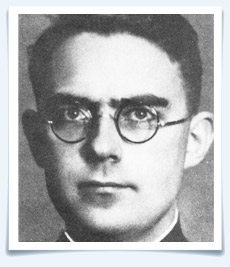Hermann Lange
Portrait
While Johannes Prassek was an offhand preacher, not bound by any manuscript, Hermann Lange, on the other hand, became known among catholics for his methodical, literally well prepared sermons. His listeners soon recognised in them his passion for pedagogy.
For Lange, born in 1912 in Leer, East Friesland, his uncle Hermann Lange, cathedral dean in Osnabrück, was an impressive model, also in respect of choice of profession. Early on he joined the „Bund Neudeutschland“ (ND) (New-German League). The ND was a catholic youth organisation for high-school and university students, who saw themselves as a bridge between Church and intellectuals. They strove for a renewal of Germany in the Christian spirit. Lange became leader of the Leer group already while in high-school. As a final year high-school and then as university student he became enthused by the religious philosopher Romano Guardini and the liturgical renewal movement he inspired, a movement which anticipated some reforms of the Second Vatican Council already in the 20s.
Lange was a thoroughly analytical, and not just in theological matters, highly educated personality. Besides the Eucharist, the proclaiming of the Word of God was central to his understanding of the role as a priest; in that he was close to the concerns of the reformatory churches. He rejected the ideology of National Socialism outright. Because he saw war as a core element of that ideology, he did not shy away from telling young soldiers in discussions, that participation in a war was fundamentally unacceptable by the Christian faith, Thus, he went far beyond the official stance of the then Church. This rejection of war shows the firm, focussed conviction of his thinking.
Original GermanText: Ökumenischer Arbeitskreis „Lübecker Märtyrer“
English Translation: Hans-Heinrich Boeker, Wyoming, Australia
proceed to portrait of Eduard Müller









